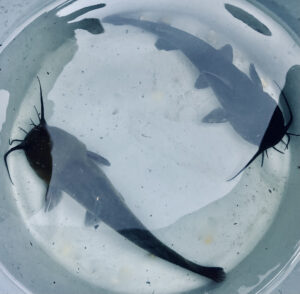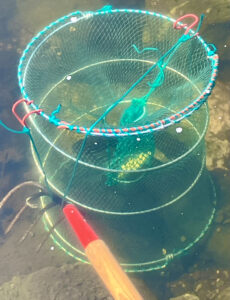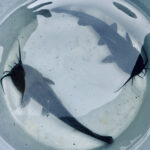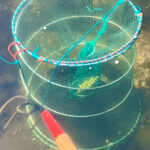 A few weeks ago, I noticed something strange at the bottom of our frog pond: what appeared to be two dark fish, swimming in circles. They looked like carp, each about 8 inches long. But how did they get there? Our pond is small, self-contained, and pump fed. Could a passing bird have dropped them in? I once saw a crane stalking around the area, but it seemed to be looking for fish, not disposing of them. As the days passed and the two fish kept circulating, I noticed the frog population seemed to be thinning out. I’ve grown to love our frogs, and I couldn’t help but worry: could the carp be eating them? “Carp have a tendency to eat almost anything,” the internet informed me, “bottom matter or even minnows, crawfish and frogs.”
A few weeks ago, I noticed something strange at the bottom of our frog pond: what appeared to be two dark fish, swimming in circles. They looked like carp, each about 8 inches long. But how did they get there? Our pond is small, self-contained, and pump fed. Could a passing bird have dropped them in? I once saw a crane stalking around the area, but it seemed to be looking for fish, not disposing of them. As the days passed and the two fish kept circulating, I noticed the frog population seemed to be thinning out. I’ve grown to love our frogs, and I couldn’t help but worry: could the carp be eating them? “Carp have a tendency to eat almost anything,” the internet informed me, “bottom matter or even minnows, crawfish and frogs.”
 I knew I had to get them out. I tried to scoop them up with a butterfly net but they just darted away under the rocks. So I consulted the digital authorities, and ended up purchasing this crayfish trap, made in China of mostly green plastic twine. As recommended, I baited it with corn kernels and dropped it into the deepest part of the pond. The next morning, what turned out to be catfish (carp don’t have whiskers) were thrashing around inside. They’ve since been relocated to a nearby brook, but the mystery remained. How did they get into our frog pond in the first place?
I knew I had to get them out. I tried to scoop them up with a butterfly net but they just darted away under the rocks. So I consulted the digital authorities, and ended up purchasing this crayfish trap, made in China of mostly green plastic twine. As recommended, I baited it with corn kernels and dropped it into the deepest part of the pond. The next morning, what turned out to be catfish (carp don’t have whiskers) were thrashing around inside. They’ve since been relocated to a nearby brook, but the mystery remained. How did they get into our frog pond in the first place?
Very slowly, something began to take shape in the depths of my subconscious. Fragments of a memory circled through my thoughts — then surfaced in a flash of insight. Several years ago, a young nephew proudly showed me a mason jar with a couple tiny fish he’d caught in Stockbridge Bowl aswim inside. He wanted to keep them, but his family had to head back to the city and board a plane. Could he leave them behind in our pond? They were no bigger than minnows. When we gently tilted the jar into the water, the fish disappeared immediately. I doubted we’d ever see them again. The frogs, I thought, would eat them.
Here’s a lovely sonnet by the classicist and poet A.E. Stallings that is nominally about fishing but has a lot to say about fathers and daughters.
Fishing
By A.E. Stallings
The two of them stood in the middle water,
The current slipping away, quick and cold,
The sun slow at his zenith, sweating gold,
Once, in some sullen summer of father and daughter.
Maybe he regretted he had brought her—
She’d rather have been elsewhere, her look told—
Perhaps a year ago, but now too old.
Still, she remembered lessons he had taught her:
To cast towards shadows, where the sunlight fails
And fishes shelter in the undergrowth.
And when the unseen strikes, how all else pales
Beside the bright-dark struggle, the rainbow wroth,
Life and death weighed in the shining scales,
The invisible line pulled taut that links them both.




That is a real interesting story about the catfish and how they most likely got there ! May the frogs continue to enjoy their home.
Thank you, Cheryl. The frogs are back — and have invited their friends.
Fish eggs can hitch a ride on bird and animal feet, fur, and feathers.
They can also be dropped by birds of prey, but given that you have two fish, that seems less likely. Also unlikely but possible: recent studies have demonstrated that the eggs of some species can survive a trip through a bird’s digestive system; catfish can wash from one pond or stream to another during heavy rains; and some species of catfish can transport themselves over land.
I should have read to the end before posting! But I’m glad they are still out there, submerged somewhere nearby. If the sea around Bishop’s fishhouses is like what we imagine knowledge to be, maybe your catfish are like what we imagine memory to be.
I was actually going to use the Bishop with this, but it’s as big and wide as the ocean. A fresh water poem seemed more appropriate. Fish as memory — how apt and beautiful.
This is fascinating information, Bruno. Thank you. I’ve read that catfish can walk — it would have been a lot easier for me if they’d done just that.
Love this story and poem! Thanks,!
Thanks, Phyllis!
Yikes – what a fascinating fish story. Hope the frogs survive!!
They seem to be thriving now, Margie. For them, it must have been a bit like the Loch Ness monster had taken over their home.
Amazing that you didn’t see the transformation from tiny to quite large. Where were they in between?!
That’s a good question, Susan, and I don’t have a ready answer. Growth spurt perhaps?
Hi Liza,
Those fish appear to be what are popularly called “bullhead”. They are found in shallow warm waters in West Stockbridge. My father and I would catch them in Card Pond.
Thank you so much for this, John. I looked up bullheads and apparently they are a variety of catfish — those whiskers give them away.
Hi Liza,
Loved the story and how it unfolded, And of course, the perfect poem to go with it!
Beata
Thank you, Beata!
Yup, catfish! It’s good you removed them…they can get big!
And they look like gangsters or bandits — with those drooping mustachios!
BarryAWOTC
I hope those frogs appreciate what you did for them, wouldn’t want anymore to croak.
(Sorry, couldn’t resist.)
Having two daughters I found the poem to be very sweet.
Nice, as always, to hear from the sage on the couch. Glad you liked the poem, too. That last line is a beauty, isn’t it?